Velotric Nomad 2 Review | Roam Free In Comfort & Style
A responsive, powerful, and HUGELY customizable fat tire e-bike for commuting, cruising, or adventuring.
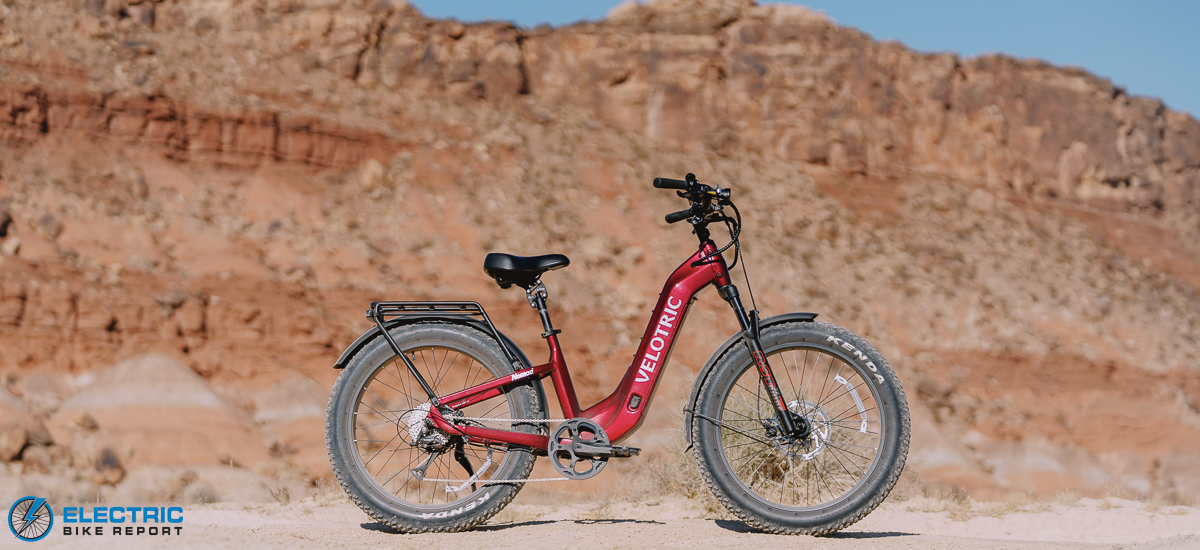
Here at Electric Bike Report, our team has had the pleasure of reviewing nearly every e-bike released by Velotric since the brand’s inception. While the company’s first-generation models were appealing due to their bright colors and overall value/affordability, many of them were admittedly fairly basic.
We were highly impressed with the leap made by Velotric’s second-gen commuter e-bike, the Discover 2, and have anxiously awaited the release of other updated models. Now, with the Nomad 2 in hand, we’re thrilled to see that the brand’s fat tire e-bike received the same upgrades and redesign.
There’s no getting around it: the Nomad 2 is a beautiful bike. It has an angular frame with a glossy, automotive-quality paint job decked out with black trim. Great looks have been one of Velotric’s hallmarks from the beginning, and this bike continues the trend.
More importantly, it also has a robust suite of features and a huge range of customization. Whether through the bike’s display menu or the Velotric app, riders can alter the bike’s speeds, choose from three riding modes with different ranges of power levels, and switch between torque and cadence sensing modes to change the feel of the ride.
The bike includes standard features such as integrated lights and fenders, a powerful 750W rear-hub motor, and a sizable 48V, 706 Wh battery. Its ride quality is elevated by extras such as an MIK-HD cargo rack with 66 lbs of carrying capacity, integrated turn signals, a cruise control function, a rocker-style suspension seatpost, and more.
Is this the most comfortable and customizable fat tire e-bike on the market? Our team of test riders put it through our series of standardized performance tests to answer that question and more. See our full review below for the verdict!
**Use code: EBRN201 for a special discount Velotric is giving our readers only at checkout**
Class 2 (throttle to 20 mph)
Class 3 (pedal assist to 28 mph)
 Pros
Pros- Whether you prefer a low-power, analog-like feel or an easy, high-power experience, the Nomad 2’s motor delivers power quickly and fluidly. This is Velotric’s most responsive torque sensor to date!
- The bike has a remarkable level of customization over its ride feel, operation, and speed. Choose from 3 power ranges for its five assist levels, as well as torque/cadence modes, separate throttle & pedal assist speeds, and more!
- The Nomad 2 has one of the smoothest rides imaginable! It’s extremely stable and comfortable thanks to its 4” fat tires, full suspension, swept-back handlebars, and huge, cruiser-style saddle.
- This bike is packed with features: it includes lights, turn signals, fenders, a MIK-HD cargo rack with a 66-lb capacity, a cruise control function, Apple Find My™ technology, and more.
- The Nomad has one of the highest total payload capacities we’ve seen on an e-bike, with the ability to carry up to 505 lbs and tow up to 1,000 lbs.
- With two frame sizes, two frame styles, and an adjustable stem, and a standover height as low as 16”, the Nomad 2 fits riders from 5’2” to 6’5”.
- The Nomad 2’s battery is IPX7 waterproof and carries UL 2271 certification, while the bike itself has an IPX6 rating and UL 2849 certification.
- With five glossy color options, the Nomad 2 has a refined, automotive-quality finish with lots of personality.
 Cons
Cons- The Nomad’s total of 15 assist levels felt like too many options. We feel that offering three to five customizable assist levels would be a better approach.
- The bike exceeded the Class 3 speed limit of 28 mph in our Speed Test. It’s fun, but we encourage Velotric to implement a harder top-end limit.
- Battery: 48V, 14.7Ah (705.6Wh), IPX7, Certificated by UL 2271
- Display: 3.5″ Full color, High brightness, Bluetooth, Adjustable angle
- Motor: 48V, 750W 90Nm (1300W Peak)
- Headlight: Light sensing 130 Lux /500 LM high-output integrated LED, adjustable angle
- Taillights:Braking Indicator, turn signal, rear light steady/flash, integrated with rear rack
- Pedal Assist: 3 Riding Modes x 5 PAS Levels
- Claimed Range: 45 Miles (Throttle), 65 Miles (Pedal Assist)
- Throttle:Trigger-control, removable
- App:Velotric
- UL Certification:UL 2271 and UL 2849 Certified
- Claimed weight: 75 lbs
- Tested Weight: 84 lbs (with 10-lb battery)
- Rider height range: 5’2”~5’11” (Regular), 5’10”~6’5” (Large)
- Total payload capacity: 505 lbs
- Brakes:Tektro Hydraulic Disc Brake, 203mm front/180mm rear rotors
- Fenders:front and rear full coverage
- Fork:RST Hydraulic suspension 100mm travel with Lock-out, Nutted
- Frame: Triple-Butted Aluminum Alloy
- Drivetrain:SHIMANO 8-speed, 48T chainring, 11-40T cassette
- Grips: Durable ergonomic grips, lockable
- Saddle: Velotric Comfortable & Ergonomic Seat
- Handlebar: Aluminum Alloy, Ф31.8mm, 680mm(R)/700mm(L)
- Kickstand: Aluminum Alloy, included, rear mount
- Pedals: Plastic
- Tires: KENDA 26×4.0″ eBike puncture-resistant tires

The Nomad 2 is well equipped to ride both on- and off-road thanks to its full suspension, powerful motor, and 26×4” knobby fat tires.

The proprietary 750W rear-hub motor can deliver an active or relaxed experience to match any rider’s style.
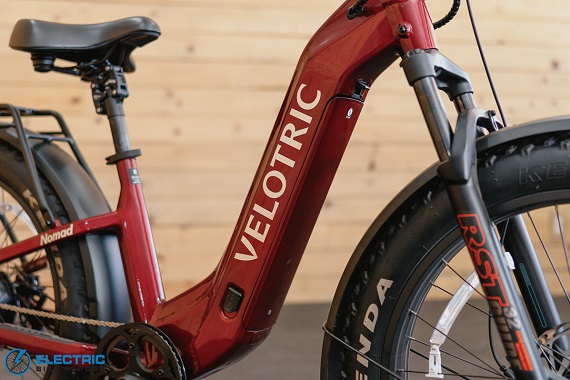
A 48V, 706-Wh battery is fully integrated into the down tube. It’s IPX7 waterproof and UL 2271 Certified, too!
Velotric Nomad 2 Review: Speed Test

While its speeds are completely customizable up to a maximum of 28 mph, the Nomad 2 ships as a Class 2 e-bike with throttle and pedal assist up to 20 mph. We tested it as a Class 2 and Class 3 e-bike in our Speed Test by riding on a flat section of a paved shared-use path while recording our average speeds.
In most cases, only these two tests are needed, but the Nomad 2 added a few uncommon variables. The bike has three riding modes (Eco, Trail, and Boost) with low, medium, and high power ranges that are further divided into five assist settings. We exclusively Boost mode to avoid performing 12 separate tests (this felt a bit excessive), but we tested the bike in both its cadence and torque sensing modes. See the graph of our results above.
Before diving into the analysis, it’s worth explaining the difference between the Nomad’s torque and cadence sensing modes. When using the cadence sensor, the bike has preset speed limits in each power level, and its ability to reach those speeds is not affected by how much pressure is applied to the pedals.
In the torque sensing mode, the bike is only limited by its maximum speed. Additionally, the motor senses when the rider applies more pressure and responds by outputting more power. Conversely, with less pressure applied to the pedals, the motor output decreases.
When looking at the cadence mode tests, our data shows that the speed limits for each pedal assist setting are relatively evenly spaced. We find that such incremental jumps in speed and power feel intuitive, and we like that this style of programming gives riders a high degree of control over their speed.
Overall, the bike performed well in this portion of the test, though I was able to exceed the 28 mph limit by a significant margin in PAS 5. I enjoy riding fast as much as the next person, but for the sake of safety and legality, we encourage Velotric to implement more strict limits at 28 mph to ensure that the bike can be ridden in more areas.
In the torque mode tests, the bike’s power levels felt intuitive; this is reflected in the Class 3 data, but the Class 2 data shows three assist levels with the same result. We attribute this skew toward higher speeds to the high motor output in Boost mode.
With no individual speed limits and a heap of motor power, reaching 20 mph was possible (and relatively easy) even in PAS 1 or 2, so it was unsurprising that PAS 3, 4, and 5 all shared the same results. The lower power levels of Eco or Trail mode felt noticeably more reserved, so I expect my results would have differed more widely in either of those modes.
The Nomad 2’s throttle felt steady and strong without being overpowered or punchy. I liked that this gave the bike an approachable feel, as many fat tire bikes can quickly feel overpowered and liable to get out of control. I also liked that I could adjust the bike’s throttle and pedal assist speeds separately!
Generally speaking, Velotric did a great job with the Nomad 2’s programming, and we appreciate the brand’s efforts to cater to different riders with so many power levels to choose from. That said, the total of 15 power levels felt like too many options.
We’ve tested quite a few e-bikes from other brands offering three to five pedal assist settings with customizable power levels through a smartphone app. For the sake of user-friendliness and approachability (not to mention ease of testing), we think this might be a better direction for Velotric in the future.
As it is, the division of power between the bike’s five assist levels is intuitive, and the overall power levels of its three riding modes make sense. Eco mode felt best for those who want a relatively natural, analog-like feel. Boost was clearly optimized for those who want the easiest possible ride. Trail mode fell between those extremes—but skewed a little more toward the reserved feel of Eco.
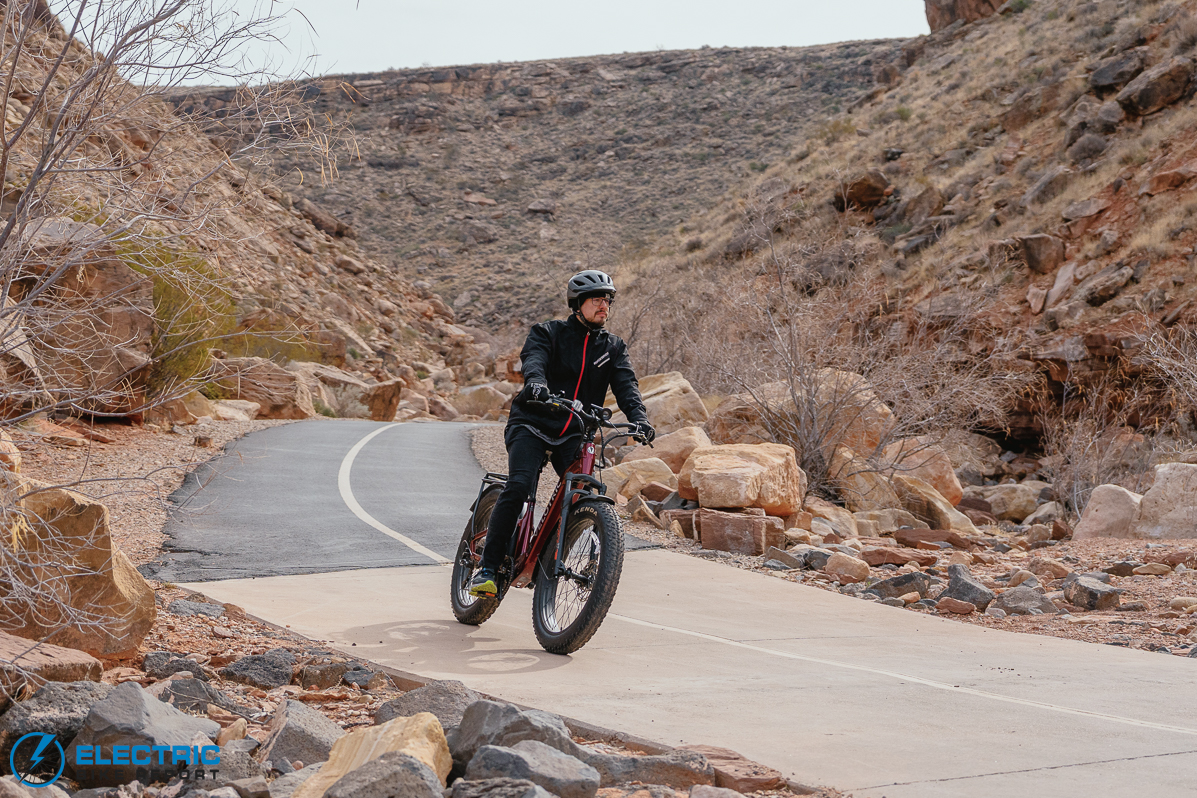
As a fat tire e-bike, the Nomad 2 feels remarkably stable and stuck to the ground even when riding at higher speeds.
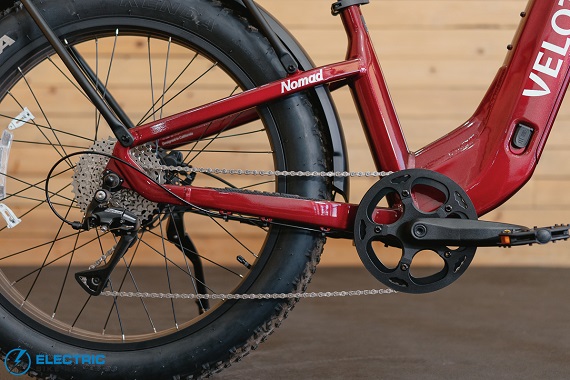
An 8-speed Shimano Acera drivetrain with an 11-40T cassette offers a wider gearing range than many similar models we’ve tested.
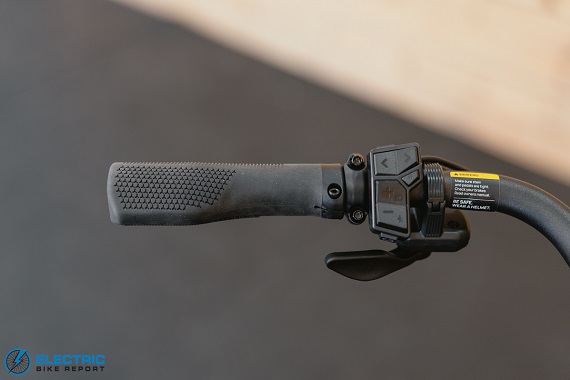
The bike’s throttle lever and multi-button control panel are placed within easy reach of the ergonomic rubber grips.
Velotric Nomad 2 Review: Range Test

**Use code: EBRN201 for a special discount Velotric is giving our readers only at checkout**
While our general Range Test process is explained in the graphic above, the Nomad 2’s sensor and riding mode variables require additional explanation. In both tests, we set the bike to its torque-sensing mode and kept its maximum speed at 20 mph (as the bike ships).
We tested the Nomad 2 in Boost/PAS 5 for its high-power test. We chose Eco/PAS 3 for its low-assist test, as PAS 1 and 2 didn’t quite deliver the power that we think most riders will prefer.
Our results of 23.6 and 67.1 miles prove that Velotric’s advertised range of 65 miles is definitely doable. Riders willing to pedal with minimal pedal assist may be able to exceed that figure.
Other fat tire e-bikes we’ve tested averaged 31.9 and 57.8 miles, so the Nomad 2’s 706-Wh battery yielded roughly 8 miles fewer than average in its high-power test. Conversely, it gave us roughly 9 miles more than average in its low-power test!
We consider these overall bookend values to be both practical and reasonable, considering the Nomad 2’s specs and power levels. In truth, the bike’s battery is somewhat smaller than average in comparison to many of its peers (those bikes averaged 798 Wh), so we would not have been surprised to see below-average results in both tests.
The bike’s 750W motor does not hold anything back in its Boost riding mode; we found that, in addition to plentiful speed and power, the bike burns through battery power relatively quickly in PAS 5. With this in mind, there is some incentive to use a lower assist level or riding mode when looking to stretch out the battery’s charge.
Conversely, the power range of the Eco riding mode is functional but still relatively low in the grand scheme. This conservative power level, combined with the bike’s torque sensor, helped to extend its charge in the bike’s low-assist test.
Torque sensors are naturally more efficient than cadence sensors since they allow the motor’s power output to fluctuate instead of remaining constant. When switching between torque and cadence sensing modes, the Velotric App will show a reminder indicating that riders should expect a lower range in the cadence mode.
We can estimate the bike’s range in the cadence sensing mode by dividing its battery capacity in watt-hours (706) by its motor’s nominal wattage (750). We anticipate that riders using Boost mode in PAS 5 while relying on the cadence sensor should expect roughly 15 miles of range and a ride time of approximately 56 minutes, though it is possible the bike could exceed this estimate.
Our test showed that the Nomad 2’s battery is sizable enough (and its motor is efficient enough) to support long rides regardless of what the bike is used for. With the right power levels and sensor modes, we consider its range appropriate for riding to work every day or venturing off the beaten path in the evenings or weekends.
Since the Nomad 2 offers so many customization options, we recommend performing your own range test when you find the settings that work for you based on what you do with the bike. We also suggest sticking close to home once the charge level gets low, as all fat tire e-bikes can be relatively tough to pedal once their battery dies due to their weight.
While it’s possible—and even likely—that most riders should get multiple rides from a single charge, the bike will inevitably need to be plugged in. We were pleased to note that the Nomad 2 comes with a 3-amp fast charger that can totally recharge the battery in about 5 hours, so you won’t have to wait too long before getting back out there!
Velotric Nomad 2 Review: Hill Test
The results shown in the graphic above lined up closely with the category averages based on other fat tire e-bikes we’ve reviewed. The pool of bikes used for comparison averaged 1:23 on throttle and 1:13 using their highest level of pedal assist.
These results make sense based on the bike’s weight and overall motor output. At 84 lbs including its 10-lb battery, the Nomad 2 is roughly five pounds heavier than average. Its motor produces 90 Newton meters (Nm) of torque, which is spot on with the category average. Finally, its motor’s peak of 1300W is on the higher side among other e-bikes with 750W motors. These three factors seemed to balance out to give the bike a steady but not overpowered feel when approaching hills.
Clearly, the Nomad 2 had the power to conquer Hell Hole Trail and keep up with its peers, but the bike still has an unused ace up its sleeve.
E-bikes with cadence sensors tend to be faster in this test than those with torque sensors, and they usually deliver an easier experience overall. Riders looking to minimize their effort could switch to the Nomad’s cadence-sensing mode for a more relaxed climbing experience. The Nomad 2 delivers the best of both worlds!

The Nomad 2 comes in a variety of color options, including Cranberry (pictured), Midnight Blue, Oliver, Slate, and Sage.
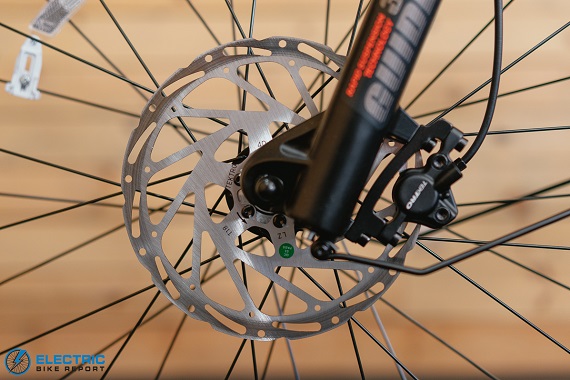
Velotric wisely specced the Nomad 2 with a 203-mm front rotor and a 180-mm rear rotor.
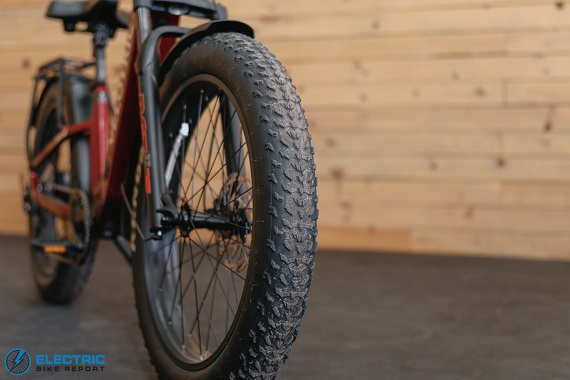
Knobby tread on the bike’s fat tires give it great traction on dirt or gravel.
Velotric Nomad 2 Review: Brake Test

Using the method described above, we determined the Nomad 2’s average stopping distance to be 20’9”—a fantastic result for the fat tire category! Like the Nomad, e-bikes of this style tend to be relatively large and heavy, which requires their brakes to work harder when slowing the bike down. As such, fat bikes often have fairly long stopping distances.
Case in point: other fat tire e-bikes we’ve tested averaged 22’9”, making the Nomad 2’s result exactly two feet better than average.
As we would expect for such a beefy bike, the Nomad 2 is equipped with a hydraulic disc brake system (the Tektro TDK171 model) that uses two-piston calipers. There is one key element of the Nomad’s system that gave it an edge and differentiates it from most similar bikes we’ve tested: its brake rotors.
Where most of the other fat tire e-bikes had similar hydraulic disc systems paired with 180mm front and rear rotors, the Nomad 2 sports a larger 203 mm rotor on its front wheel (and a 180mm rotor on the rear). This larger rotor provided more leverage when braking force was applied, which helped to offset the Nomad’s higher-than-average weight and give it an above-average result.
The extra force was noticeable going by feel as well; I wouldn’t say the Nomad 2 can stop on a dime, but its brakes felt powerful and effective. The bike also remained stable and straight when it was coming to a stop, giving it an extremely safe feel. Due to its performance and feel, we consider this brake system a great pairing with this bike!
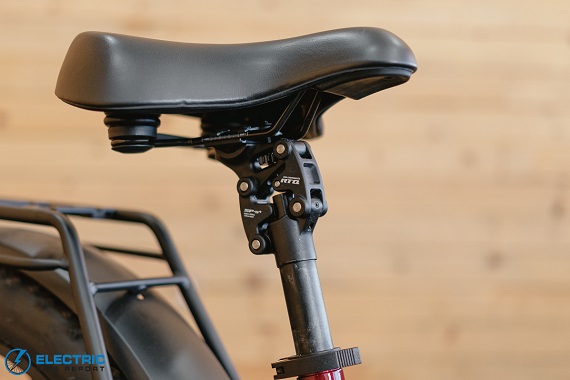
The bike’s extra-wide spring saddle is roomy, plush, and mounted to a rocker-style suspension seatpost.
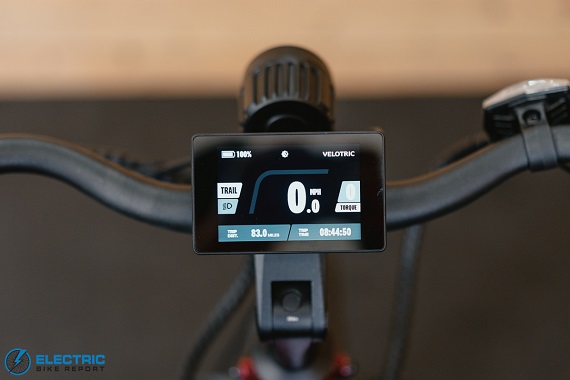
A full-color display presents data in a clear and organized manner. The bike can be customized through its settings menu or the Velotric app.

An adjustable stem allows users to fine-tune the bike’s fit and riding position to optimize comfort.

The Nomad features a MIK-HD cargo rack that can be equipped with locking storage and passenger accessories.
Velotric Nomad 2 Review: Ride Quality
With its powerful motor, knobby tires, and full suspension—including a lockout suspension fork with 100mm of travel and a suspension seatpost with 50mm of travel—the Nomad can be ridden just about anywhere outside of dedicated mountain bike trails. This makes the bike ideal for paved bike paths, dirt roads, gravel multi-use trails, etc.
I found the Nomad 2 to be a remarkably comfortable ride thanks to its full suspension, shock-absorbing fat tires, and extra-wide spring saddle. The saddle is something I’d liken to a sofa or La-Z-Boy; it’s one of the largest, thickest, and most comfortable I’ve encountered. There was enough cushion beneath the Nomad 2 that I hardly noticed any bumps!
In terms of sizing and fit, the Nomad 2 is offered in two frame styles (high-step/step-over and step-thru/ST) and two frame sizes. The Regular size fits riders from 5’2” to 5’11”, while the Large accommodates those from 5’10” to 6’5”. Velotric advertises that the ST frame can fit riders as low as 4’11” without its suspension seatpost; buyers may need to contact the brand directly to exchange the suspension seatpost for a standard model.
At 5’11”, I expected our Regular-size test bike to feel somewhat on the smaller side, but I was pleasantly surprised by how well it fit. In contrast with most bikes, I would likely opt for the smaller frame size based on my test experience.
With roughly 6” of adjustability in saddle height, I enjoyed full leg extension for efficient pedaling. The bike’s adjustable stem allowed me to set the handlebar height/reach at a comfortable position.
It’s worth mentioning that the high-step and ST models have a few slight differences. The step-thru that I spent most of my time riding has no top tube and a standover height of just over 16 inches, making it nearly effortless to get on and off the bike and removing the need to swing a leg over the saddle.
There are also differences in handlebars; the high-step frame comes with moderately curved ergonomic handlebars, while the ST model features more aggressively swept-back handlebars appropriate for a cruiser-style e-bike. Both were comfortable, though personally, I preferred the high-step’s handlebar shape.
As with most fat tire e-bikes, the Nomad 2’s size and weight are noticeable when riding and cornering. That is to say that maneuvering can be somewhat slower than on smaller, lighter e-bikes. With that in mind, the Nomad 2 handled well for its size, and its stability and solidity are tradeoffs for its less-than-nimble feel.
Generally speaking, I found that the Nomad checked all the appropriate boxes for a fat tire e-bike, but I believe Velotric kicked things up a notch (or three) with all of its integrated features and technology.
I’ve already mentioned many of the bike’s customization features, including the ability to adjust the bike’s throttle and pedal assist speeds separately, switch between riding modes, select either the torque or cadence sensing modes, etc. Users can also change the brake light behavior, activate a cruise control mode, and engage a low-light sensor for the integrated headlight and tail lights.
These features can be accessed either through the Velotric app—which also offers ride data tracking—or the Nomad 2’s full-color display. The display shows color-coded pedal assist levels, a power meter, and all standard ride data; it’s clear, appealing, and easy to read.
For security, the bike offers compatibility with Apple’s Find My™ technology. In the event of theft, users can track the bike’s location via GPS, and the location will update as long as the bike is near a Bluetooth-enabled Apple device.
Clearly, the Nomad 2 is much more than just a bike; it’s a high-tech, versatile, and highly adaptable e-bike with fantastic ride quality.

The integrated 500-lumen headlight features an optional low-light sensor to provide illumination when it’s needed.
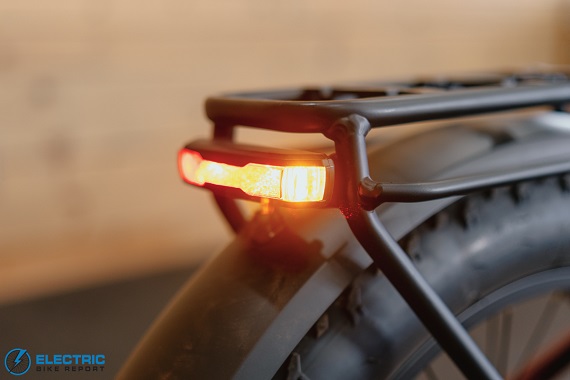
A tail light mounted to the cargo rack features brake light functionality and turn signal lights.

The step-thru or ST frame features a 16” standover height for easy mounting and dismounting.
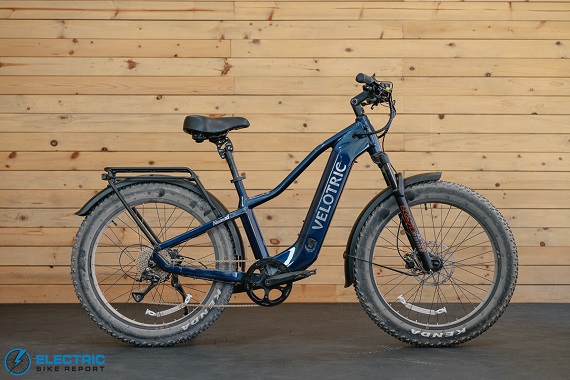
The Nomad 2 is also available in a high-step frame with either a 28.5” or 29.5” standover height.
Velotric Nomad 2 Review: Summary / Where to Buy
We’ve seen the brand grow by leaps and bounds as we’ve reviewed nearly every e-bike Velotric has released. With every new model, the company has evolved to its current status as a true leader in the industry, and the Nomad 2 perfectly showcases Velotric’s experience.
The bike is also an excellent example of Velotric’s intention to make e-bikes with tons of mass appeal. Fat tire bikes can be attractive to a fairly wide range of riders, including older folks who value their stability, adrenaline junkies who like speed and power, and adventurous types who want a lot of freedom in where they can roam.
With so many customization options, we’re confident that the Nomad 2 can satisfy all of those crowds equally. That’s a tough thing to pull off!
**Use code: EBRN201 for a special discount Velotric is giving our readers only at checkout**
Our only real points of critique are the Nomad’s somewhat overwhelming number of pedal assist settings and its ability to exceed 28 mph. We encourage Velotric to implement stricter speed limits and offer fewer pedal assist levels in the future. Ideally, we’d also prefer the ability to tailor the bike’s individual power levels through the Velotric app.
Otherwise, the Nomad 2 proved to be extremely responsive and comfortable in addition to showing admirable performance in our series of standardized tests. It has great programming, excellent stopping power, fantastic range, and solid climbing ability. If you ask me, it’s hard to deny that it looks pretty awesome too!
We recommend the Nomad 2 as a reliable daily commuter, a leisure bike for the weekends, an off-road adventure bike—or all three! With so much versatility and so many ways to switch up the feel and function of the bike, why choose just one?
Happy Riding! Make sure to let us know if you have any questions or if you think we left anything out in this review of the Velotric Nomad 2 down in our comments section.



Have you ever thought about adding some kind of Slalom course to your testing? It could be a way to test the rigidity and handling of the bikes that you test. Possibly some cones set up certain distances apart.